If you ever cruise around social media – especially Instagram and Pinterest – you’ll often come across embroidery or other needlework that’s based on or inspired by other works of art from the past.
Van Gogh’s Starry Night shows up in surface embroidery quite a bit! Or the girl with the pearl earring – did Vermeer know that his tronie would show up in cross stitch, in surface embroidery, even in goldwork 350 years later?
We would be a dried up and dead world, completely disconnected from our roots, if we did not draw inspirations from previous centuries for any of our artistic pursuits. Just as ideas build on previous ideas, just as inventions morph from previous inventions, art builds on art. That’s the nature of the development of human endeavor.
Today, by way of introduction, I’m going to babble a bit about some of my favorite pieces of art that have been on my mind and in my needlework plans for a long, long while. And, for all you art, history, and textile enthusiasts, you’ll find an interesting lecture about these works of art at the end of today’s article.
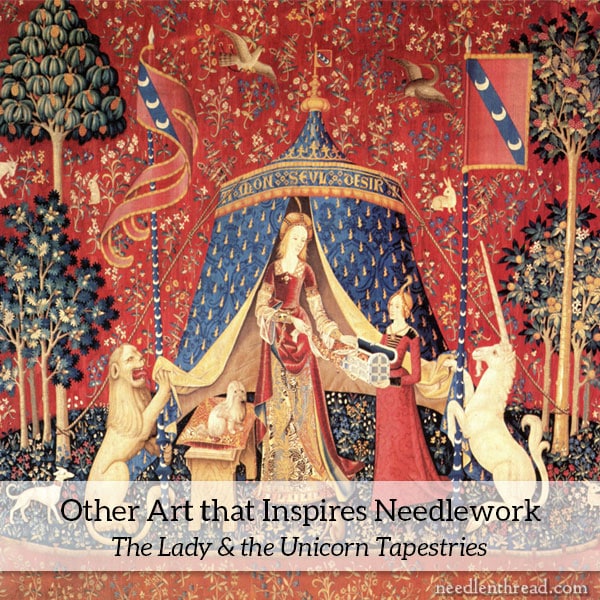
There are two eras of art that I turn to for inspiration frequently, with my favorite being the art of the late Middle Ages as it morphs into the early Renaissance.
Medieval art fascinates me. It’s art filled with layers and layers of meaning. And whether it’s the iconography of the Middle Ages, whether it’s textile art (embroidery, tapestry weaving), whether it’s illumination and calligraphy, sculpture – I find myself drawn to all of it.
Among the famous works of textile art of the late Middle Ages, I am most infatuated with the Lady & the Unicorn tapestries that are found in the Musée de Cluny in Paris.
Lately, I’ve been working up, in needlework, my own little tribute to them and to other similar tapestries.
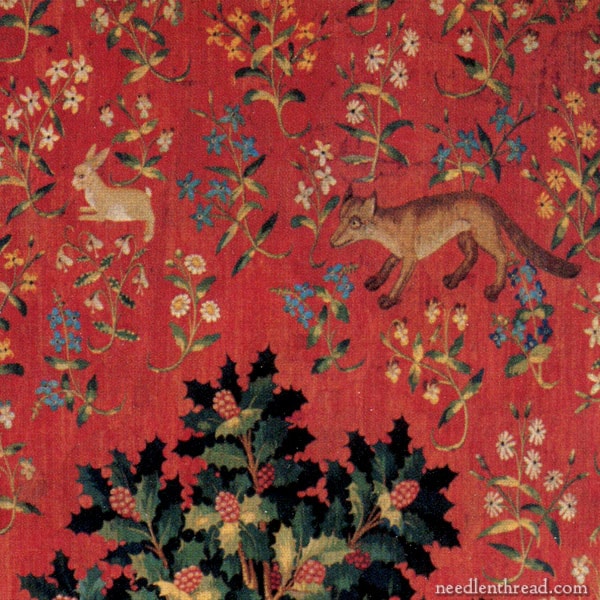
Ever since I first encountered the tapestries in a history of art class back in college, I wanted to make one.
No, no. Not really. Not a whole one!
I was enchanted by the background of the tapestries, more than anything else. I love the millefleur (thousand flower) backgrounds, bespeckled with almost caricatured animal life. From rabbits to dogs to cats to birds and monkeys – all the little animals in their floral surroundings impart a sense of life, vibrance, and a bit of forest-like magic that you find in the best fairy tales, folklore, and legends.
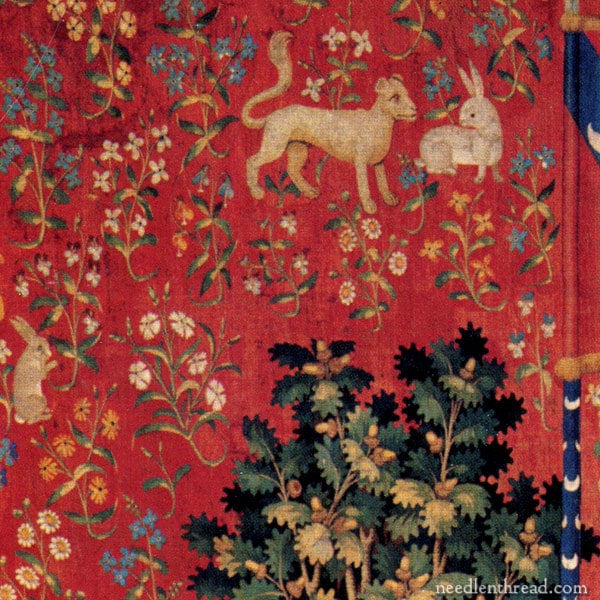
When I was in college, I had no idea how to go about designing anything, really. I just new I wanted to make that background in stitchery, somehow.
I tried dabbling with the flowers in surface embroidery, with DMC on red cotton. It didn’t make my heart sing. And I put the idea aside.
Over the years, though, I tried different renditions of the tapestries in other forms of needlework. I’ve tried regular needlepoint versions. I’ve tried crewel variations.
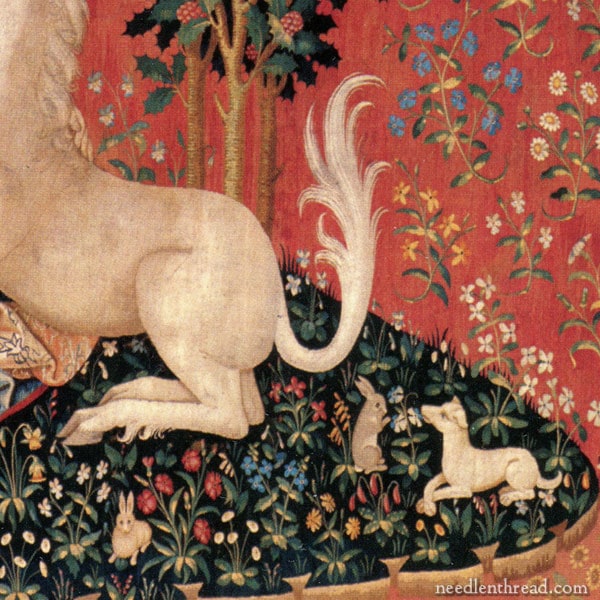
The closest I’ve come to really enjoying something Unicorn-Tapestry-Stitchable, though, was when I worked this miniature rendition of the Sense of Hearing tapestry.
I enjoyed stitching that piece. I used it as a “15 Minute Project” and I really liked watching it develop!
But I continued to treasure the idea of working up my own adaptation of just the background tapestry elements. And earlier this year, I designed one small piece to stitch.
I gathered my favorite types of threads to stitch it. And I didn’t limit myself in color choice. After all, I figured if I’m stitching something inspired by my favorite works of art, I should put the best of everything I had into it.
I liked it!
So I designed a few more and then picked my favorites to stitch. I didn’t try to make them look particularly early-Renaissance. After all, if art and craft are absolute imitation, they would never move forward. (That’s my excuse, anyway.) I chose whatever animals I like, whether they show up traditionally in these early tapestries or not.
Finally, when I finished stitching the fourth one, I felt as if I’d fulfilled a little secret dream of mine. I created little bits of stitchery inspired by some of the great works of art that fascinate me most!
This week, I’ve been doing the finishing work on my four tapestry smalls. Next week, I’m going to show them to you and tell you more about them. I can’t wait for you to see them – they were fun to stitch and they’re equally fun to finish and display!
The Lady & the Unicorn Tapestries Lecture
For those of you who are into the history of textiles, who are enchanted by the Unicorn tapestries housed at Cluny, or who enjoy the history of art in general, here’s a video of a lecture by Dr. Elisabeth Taburet-Delahaye, director of the Cluny museum since 2005, given in Melbourne while the tapestries were exhibited in Australia recently.
In the lecture, Dr. Taburet-Delahaye discusses the significance of the tapestries and shares the process of the recent restoration work that the tapestries have undergone.
If you click on the image below, it will take you to the video on YouTube:
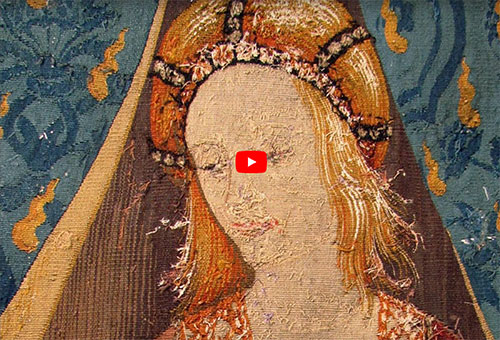
Enjoy this gem – I’m so glad they put it on YouTube for the rest of us!







Great article and thanks for the video! I, too, love these tapestries. Did you know that Tracy Chevalier also wrote a novel called The Lady and the Unicorn? I enjoyed ready it before seeing the tapestries. Although it is historical fiction, reading it provided a good context for understanding the time period and the way tapestries were made.
I love your website and blog. I use your stitch tutorials whenever I get the itch to stitch. Such an amazing resource!
Oh…sigh…I can say exactly the same thing. I love Medieval art, and I too, have been drawn to the millefleur areas for just forever. I have long collected bits and pieces of the Lady tapestries on address books and totes and such, and even use her picture as “me” on social media. They are indeed irresistible. Next year we are making a cross country move after 42 years in lovely New England, where I arrived in my mid-20’s from Minnesota. I have been trying to move through a New England/East Coast “bucket list” on my way to the end of my time here, and for one thing finally got myself down to the Cloisters in NYC. Have had decades of intent, and dreadful inertia over it. But I recommend it to anyone in the community who lives or travels in the area. It is all Medieval art and replicated gardens, including the millefleur-filled unicorn tapestries (not the Lady and the Unicorn–as Mary said, they are in Paris). Google! Go! A wonderful excursion for sure.
Thanks, Mary, I am truly eager to see what you have worked up!!!
Linda
Mary, you certainly know how to keep a reader on the edge of her seat! I cannot wait to see your works next week.
As another longtime admirer of these tapestries, I hope that it might interest other readers to know that a few years ago the Metropolitan Museum in NYC worked with Jenny Hart of Sublime Stitching to offer embroidery patterns inspired by the unicorn tapestries at the Cloisters. They are not by any means reproductions but have their own quirky, vibrant sensibility.
Dear Mary
Can’t wait to view your four tapestry smalls and to see how you have embroidered them and how you have adapted them. I would love to embroider one of these miniature tapestries stitching on silk gauze looks really interesting. I will put on my to do list. Thanks for sharing your current projects with us and for the video on the tapestries.
Regards Anita Simmance
Hi Mary thank you for an interesting article. By association of ideas, I wondered whether you finished the tiny Tree of Life embroidery with all the wonderful animals? Can’t wait to see what you are doing now though. Laura
Not yet, but I’m hoping to have time in January, when things calm down a bit!
LOVED your post today Mary–one can never get enough of the Unicorns! The video was great & I’m eagerly awaiting your mini tapestry creations. Funny you should mention Vermeer & the Girl with the Pearl Earring. She was my inspiration for a lace challenge in Amherst, NY this summer because, in my spare time, I am studying Rosaline Perle lace. Will send a photo so you can get a chuckle.
I learn something new every time I come here! In this case, the word tronie.
Mary, we recently had these beautiful tapestries visit us in Australia (yes, Australia!!) and I was lucky enough to see them in person. I had to travel to do so but it was so worth the effort. I am super excited to see your big reveal next week. Can’t wait.
Can’t wait to see your adaptations of the old tapestry backgrounds!
I’m a textile art history enthusiast myself. If a needlework book doesn’t include at least a brief section on the historic background of the subject in question, I’m always a bit disappointed.
Thank you for sharing the video. It’s a pity that there are no subtitles available, because I have a really hard time to understand Dr. Taburet-Delahaye (I’m no English native speaker, and she has a heavy French accent). But I’ll try it again, taking my time. This tapestry has been fascinating me from the very first moment I saw it, I desperately want to hear and understand the lecture!
Mary: we just returned from the Prado in Madrid. What a joy to again see the art here. Mostly Renaissance, but a bit of earlier times. I had to go back three times to see everything. Tapestries seen in Madrid and Toledo and Lisbon.
Mary,
I am looking forward to your ‘little’ tapestries next week. I really enjoyed this article, I have seen these tapestries in books and online but have never looked into them before, now I will have to! 🙂
Oh, Rebecca – be careful! You’ll get sucked into them! 🙂 I never tire of reading about them (and similar tapestries, like the ones at the Cloisters at the Met in NYC).
Thanks for the info!